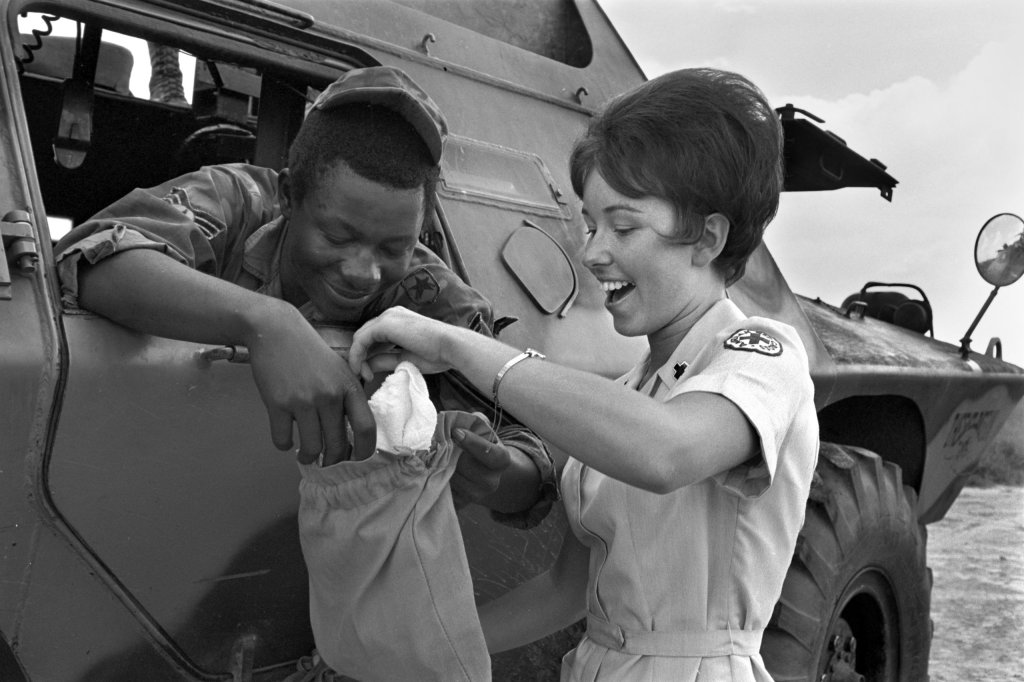American women have been on the battlefields of all our wars, at the very least on the periphery as “Donut Dollies” since the Revolutionary War. Some may recall the story of Molly Pitcher from that war, which is actually a composite story of the women who carried water, often in pitchers, to soldiers in action, often their husbands, fathers, and brothers. As the story goes, when her husband fell dead on a New Jersey battlefield, one Molly Pitcher took his place loading cannons against the attacking British.
Similar stories emerged from the later War of 1812, and a few American women managed to make their way into harm’s way during the Mexican American War of 1846, though mostly in the campaigns fought in New Mexico, not with the expeditionary forces that fought across Mexico from Vera Cruz to Mexico City.
It was the sheer size and scope of the Civil War that formally gave women a rightful place in aiding in the defense of their country. Less than a decade earlier in 1854, British nursing pioneer Florence Nightingale lead a group of over fifty volunteer women nurses, authorized by the British Secretary of War, to tend to the wounded during the Crimean War. Nightingale’s example, no doubt, was an inspiration to Clara Barton of Massachusetts to begin gathering medical supplies and tending to wounded soldiers in the chaotic early days of the Civil War of 1861-65. Although not receiving any official sanction from the Union Army until 1964, Barton, her volunteers and medical supplies were a welcome site to wounded soldiers and beleaguered military medical staffs all during the war.
On one occasion, she was so close to the fighting that a bullet ripped through her sleeve, and unfortunately struck an already wounded soldier she was tending at the time. She soon became known as the “Angel of the Battlefield,” and later she was instrumental in starting the American chapter of the International Red Cross.

During the brief Spanish American War of 1898-99, women nurses, now with more formal medical training, were contracted to work for the U.S. Army in training camps in the U.S., overseas and aboard hospital ships. Like many serving soldiers, several nurses died of tropical diseases, such as yellow and typhoid fever.
It was not until America entered the already raging World War One in 1917 did the first American women directly join soldiers in combat zones outside of the traditional nursing roles.
Again, following a British lead, women Salvation Army volunteers were soon found in the immediate rear of the battle line, serving coffee and donuts to tired, traumatized and combat-weary soldiers. The choice of preparing donuts came about through a combination of circumstances of the limited ingredients available in war-torn France and the “ease” of cooking. Soon the young ladies were affectionately being called “Donut Dollies” by the American soldiers, who happened to have the nickname “doughboys” during that war. The “Donut Dollies” were close enough to the action that they were issued soldier’s steel helmets and gas masks to protect them from artillery shrapnel and poison gas. In addition to coffee and donuts, the Salvation Army volunteers also helped with nursing, wrote and read letters for wounded soldiers, mended uniforms and many used their individual musical talents to provide informal entertainment as occasions arose.
During World War II, women Salvation Army volunteers again deployed to Europe, and the Pacific as well. Several other organizations, including the Red Cross, followed suit, and the term “Donut Dolly” became a generic reference for civilian women volunteers. This continued right through to the Korean and Vietnam Wars.

The “Donut Dollies” of the Vietnam War were part of the American Red Cross and officially called the Supplemental Recreational Activities Overseas (SRAO) staff. Understandably, the new name did not stick in country, and the “grunts of ‘Nam,” many of them the sons of GI Joes, and grandsons of doughboys, carried on calling the young American women volunteers “Donut Dollies.” These ladies had to be college graduates and for over ten years, from 1962 to 1973, over 600 volunteers traveled throughout Vietnam, by vehicle and helicopter, logging over two million miles.
In addition to spending time at rear area bases and hospitals, amazingly, military authorities allowed the volunteers to visit remote fire bases, which often came under rocket attack and were occasionally assaulted by North Vietnamese Army soldiers and Viet Cong guerilla fighters. Sadly, three Vietnam “Donut Dollies” died in Vietnam, but not from combat causes.
When American forces entered into their next major conflict, Desert Shield/Storm, women were extensively integrated into the armed forces, and the traditional wartime roles of the “Donut Dollies” had disappeared from the modern battlefield.


